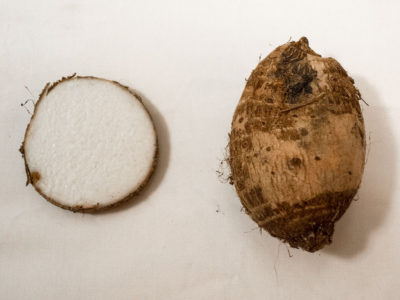Taro generally refers to the corm of a large, leafy plant (“corms” refer to a modified, underground stem – kind of like a tuber, but the purpose isn’t just storage of starch). Though it is not commonly used in the United States, taro is a staple food in African, Oceanic, and South Indian cultures, where it is believed to be one of the very earliest cultivated plants ever (isn’t that cool?!). From a cooking perspective, taro is great both alone (like in my Savory Roasted Taro) or to create a unique, creamy texture in other dishes (as in my Kale and Okra Soup) or as a starch in baking (such as my Nut-Free Paleo Biscuits).
From a nutritional perspective, taro root is almost entirely carbohydrate (34.6g/100g), but it is a decent source of dietary fiber (5.1g/100g). It’s a great source of vitamins E and B6 as well as the dietary mineral manganese. Furthermore, taro is a source of every other vitamin and mineral, but it is found in smaller or trace amounts.
You can find taro at certain grocery stores, especially in Indian/Asian or Latin markets.


 Celery Root
Celery Root